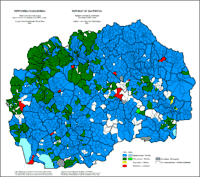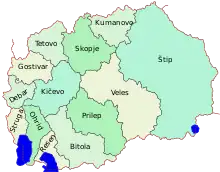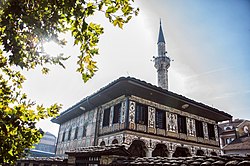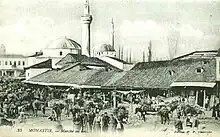Islam in North Macedonia
Muslims in North Macedonia represent just under one-third of the nation's total population according to the 2021 census,[2] making Islam the second most widely professed religion in the country. Muslims in North Macedonia follow Sunni Islam of the Hanafi madhhab. Some northwestern and western regions of the country have Muslim majorities. A large majority of all the Muslims in the country are ethnic Albanians, with the rest being primarily Turks, Romani, Bosniaks or Torbeš.

| 90–100% | |
| 70–90% | |
| 50–70% | Bosnia and Herzegovina |
| 30–40% | North Macedonia |
| 10–20% | |
| 5–10% | |
| 4–5% | |
| 2–4% | |
| 1–2% | |
| < 1% |
| Islam by country |
|---|
 |
|
|


Population
Ethnicity

Albanian Muslims, forming roughly 25% of the nation's total population (2002 census), and most of the Muslim population, live mostly in the Polog and western regions of the country. The Turks, who make up about 4% of the country's total population (2002 census), are scattered throughout the country, but mostly in major cities, as are Roma Muslims. Bosniaks are mostly concentrated within Skopje. Muslims of Macedonian ethnicity number roughly 40,000 to 100,000 and can be found in the western part of North Macedonia in the Centar Župa, Debar, Struga and Plasnica areas.
| Ethnic group | Population 1948 | Population 2002 | Population 2021 |
|---|---|---|---|
| Albanians | 197,389 | 509,083[3][4] | 446,245 |
| Turks | 95,940 | 77,959[3][4] | 70,961 |
| Romani | 19,500 | 53,879[3][4] | 46,433 |
| Macedonian Muslims | 1,560 | 2,553[3][5] | 1,187 |
| Bosniaks | 17,018[3][4] | 16,042 |
Historical population
The following table shows the Muslim population and percentage for each given year. The Muslim percentage in Macedonia generally decreased from 1904 to 1961 but began to rise again due to high fertility rate among Muslim families, reaching 33.33% in 2002. According to the census of 2021, the share of Muslims was 32.17% of the total (resident) population, which was slightly lower compared to 33.33% in the census of 2002.
| Year | Muslim population | Muslim percentage |
|---|---|---|
| 1904 | 634,000[6] | 36.76% |
| 1912 | 384,000[6] | 33.47% |
| 1921 | 269,000[6] | 31.43% |
| 1948 | 314,603[6] | 27.29% |
| 1953 | 388,515[6] | 29.78% |
| 1961 | 338,200[6] | 24.05% |
| 1971 | 414,176[6] | 25.14% |
| 1981 | 546,437[6] | 28.62% |
| 1991 | 611,326[6] | 30.06% |
| 1994 | 581,203[6][7] | 30.04% |
| 2002 | 674,015[6][8] | 33.33% |
| 2021 | 590,878[9] | 32.17% |
Geographic distribution
(according to the 2021 census)
| Municipality | Population (2021) | Muslims (2021) | Percentage (%) |
|---|---|---|---|
| Tetovo | 84,770 | 64,468 | 76.1% |
| Čair | 62,586 | 50,755 | 81.1% |
| Gostivar | 59,770 | 43,459 | 72.7% |
| Saraj | 38,399 | 35,959 | 93.6% |
| Struga | 50,980 | 32,231 | 63.2% |
| Kumanovo | 98,104 | 28,528 | 29.1% |
| Lipkovo | 22,308 | 21,570 | 96.7% |
| Bogovinje | 22,906 | 21,329 | 93.1% |
| Kičevo | 39,669 | 21,056 | 53.1% |
| Studeničani | 21,970 | 19,968 | 90.9% |
| Šuto Orizari | 25,726 | 19,350 | 75.2% |
| Vrapčište | 19,842 | 18,224 | 91.8% |
| Želino | 18,988 | 18,193 | 95.8% |
| Gazi Baba | 69,626 | 17,476 | 25.1% |
| Butel | 37,968 | 17,438 | 45.9% |
| Tearce | 17,694 | 15,144 | 85.6% |
| Debar | 15,412 | 13,611 | 88.3% |
| Aračinovo | 12,676 | 12,363 | 97.5% |
| Dolneni | 13,126 | 8,873 | 67.6% |
| Bitola | 85,164 | 8,232 | 9.7% |
| Brvenica | 13,645 | 7,386 | 54.1% |
| Veles | 48,463 | 6,286 | 13.0% |
| Ohrid | 51,428 | 5,908 | 11.5% |
| Prilep | 69,025 | 5,063 | 7.3% |
| Čaška | 7,942 | 4,710 | 59.3% |
| Radoviš | 24,122 | 4,470 | 18.5% |
| Strumica | 49,995 | 4,331 | 8.7% |
| Plasnica | 4,222 | 4,115 | 97.5% |
| Štip | 44,866 | 3,798 | 8.5% |
| Gjorče Petrov | 44,844 | 3,680 | 8.2% |
| Mavrovo and Rostuša | 5,042 | 3,669 | 72.8% |
| Karpoš | 63,760 | 3,629 | 5.7% |
| Petrovec | 9,150 | 3,588 | 39.2% |
| Jegunovce | 8,895 | 3,522 | 39.6% |
| Resen | 14,373 | 3,423 | 23.8% |
| Centar Župa | 3,720 | 3,346 | 89.9% |
| Kruševo | 8,385 | 2,859 | 34.1% |
| Vasilevo | 10,552 | 2,557 | 24.2% |
| Centar | 43,893 | 2,507 | 5.7% |
| Kisela Voda | 61,965 | 2,267 | 3.7% |
| Aerodrom | 77,735 | 2,184 | 2.8% |
| Sopište | 6,713 | 2,159 | 32.2% |
| Kočani | 31,602 | 2,069 | 6.5% |
| Valandovo | 10,508 | 1,435 | 13.7% |
| Čučer-Sandevo | 9,200 | 1,363 | 14.8% |
| Kavadarci | 35,733 | 1,157 | 3.2% |
| Negotino | 18,194 | 1,105 | 6.1% |
| Vinica | 14,475 | 942 | 6.5% |
| Karbinci | 3,420 | 865 | 25.3% |
| Ilinden | 17,435 | 855 | 4.9% |
| Gradsko | 3,233 | 740 | 22.9% |
| Bosilovo | 11,508 | 702 | 6.1% |
| Delčevo | 13,585 | 694 | 5.1% |
| Zelenikovo | 3,361 | 654 | 19.5% |
| Konče | 2,725 | 607 | 22.3% |
| Pehčevo | 3,983 | 597 | 15.0% |
| Berovo | 10,890 | 514 | 4.7% |
| Demir Kapija | 3,777 | 419 | 11.1% |
| Kriva Palanka | 18,059 | 418 | 2.3% |
| Mogila | 5,283 | 336 | 6.4% |
| Dojran | 3,084 | 309 | 10.0% |
| Makedonski Brod | 5,889 | 259 | 4.4% |
| Demir Hisar | 7,260 | 244 | 3.4% |
| Lozovo | 2,264 | 236 | 10.4% |
| Kratovo | 7,545 | 108 | 1.4% |
| Gevgelija | 21,582 | 104 | 0.5% |
| Sveti Nikole | 15,320 | 92 | 0.6% |
| Debarca | 3,719 | 76 | 2.0% |
| Probištip | 13,417 | 57 | 0.4% |
| Bogdanci | 7,339 | 52 | 0.7% |
| Rankovce | 3,465 | 52 | 1.5% |
| Rosoman | 3,796 | 36 | 0.9% |
| Novaci | 2,648 | 35 | 1.3% |
| Makedonska Kamenica | 6,439 | 18 | 0.3% |
| Staro Nagoričane | 3,501 | 14 | 0.4% |
| Vevčani | 2,359 | 10 | 0.4% |
| Krivogaštani | 5,167 | 8 | 0.2% |
| Češinovo-Obleševo | 5,471 | 5 | 0.1% |
| Zrnovci | 2,086 | 4 | 0.2% |
| Novo Selo | 6,972 | 3 | 0.0% |
| Macedonia (total) | 1,836,713 | 590,878 | 32.2% |
The Ss. Cyril and Methodius University of Skopje stated in 2012 that "religion is primary importance to Macedonia's Muslims." The university conducted a survey of 1.850 Muslims in North Macedonia, which found that 81.6% described themselves as religious, 60.5% of which were very religious. Approximately 22% never went to a mosque(48,6% attend mosque at least once a week) and 17.3% did not pray at home(42,1% pray five times a day). About 28,6% believed that disputes should be resolved using Islamic Sharia law(41,7% say that should be resolved using North Macedonia's laws,29,7% didn't know or refused to answer), and 27,8% said that wearing a veil in school was "unacceptable." 16,4% of the respondents said cohabitation without marriage was "acceptable"(74,2% said " non acceptable" and 9,3% refused to answer), 13,6% ate pork and 24,8% drank alcohol. Also 94% of respondents said they circumcised their boys and 98% observed Muslim burial practices for their relatives.[10]
According to a 2017 Pew Research Center survey, 64% of Macedonian Muslims responded that religion is "very important" in their lives.[11] The same survey found that 43% of Macedonian Muslims pray all five salah,[12] 51% attend mosque at least once a week,[13] and 46% read Quran at least once a week.That makes Macedonian Muslims the most religious Muslim community between the Balkan countries with the Muslim communities in Montenegro and Serbia.[14]
Gallery
See also
References
- "Religious Composition by Country, 2010-2050". Pew Research Center. 12 April 2015. Retrieved 22 October 2017.
- "Total resident population in the Republic of North Macedonia by religious affiliation and sex, Census 2021".
- "Statistical Yearbook of the Republic of Macedonia, 2016, p. 67" (PDF). Republic of Macedonia, State Statistical Office. 2016. Retrieved 13 June 2017.
- "Census of Pupulation, Households and Dwellings in the Republic of Macedonia, 2002, p. 591" (PDF). Republic of Macedonia, State Statistical Office. 2002. Retrieved 20 November 2016.
- Statistical Yearbook of the Republic of Macedonia, 2014, p. 67, Retrieved 11 December 2016
- Kettani, Houssain (2010). "Muslim Population in Europe: 1950 – 2020" (PDF). International Journal of Environmental Science and Development vol. 1, no. 2, p. 156. Retrieved 17 November 2016.
- Coughlin, Kathryn M. (2006). Muslim Cultures Today, A Reference Guide. Greenwood Press, Westport, Connecticut, London. p. 16. ISBN 9780313323867.
- Census of Pupulation, Households and Dwellings in the Republic of Macedonia, 2002, p. 518
- "Попис на населението, домаќинствата и становите во Република Северна Македонија, 2021 - прв сет на податоци" (PDF). popis2021.stat.gov.mk (in Macedonian). 30 March 2022. p. 82. Retrieved 30 March 2022.
- "Bulgaria's Muslims not deeply religious: study". Hürriyet Daily News. 9 December 2011. Retrieved 10 December 2011.
- "Religious Belief and National Belonging in Central and Eastern Europe: Final Topline" (PDF). Pew Research Center. 10 May 2017. p. 121. Retrieved 22 October 2017.
- "Religious Belief and National Belonging in Central and Eastern Europe: Final Topline" (PDF). Pew Research Center. 10 May 2017. p. 154. Retrieved 22 October 2017.
- "Religious Belief and National Belonging in Central and Eastern Europe: Final Topline" (PDF). Pew Research Center. 10 May 2017. p. 118. Retrieved 22 October 2017.
- "Religious Belief and National Belonging in Central and Eastern Europe: Final Topline" (PDF). Pew Research Center. 10 May 2017. p. 122. Retrieved 22 October 2017.
.jpg.webp)
.jpg.webp)







